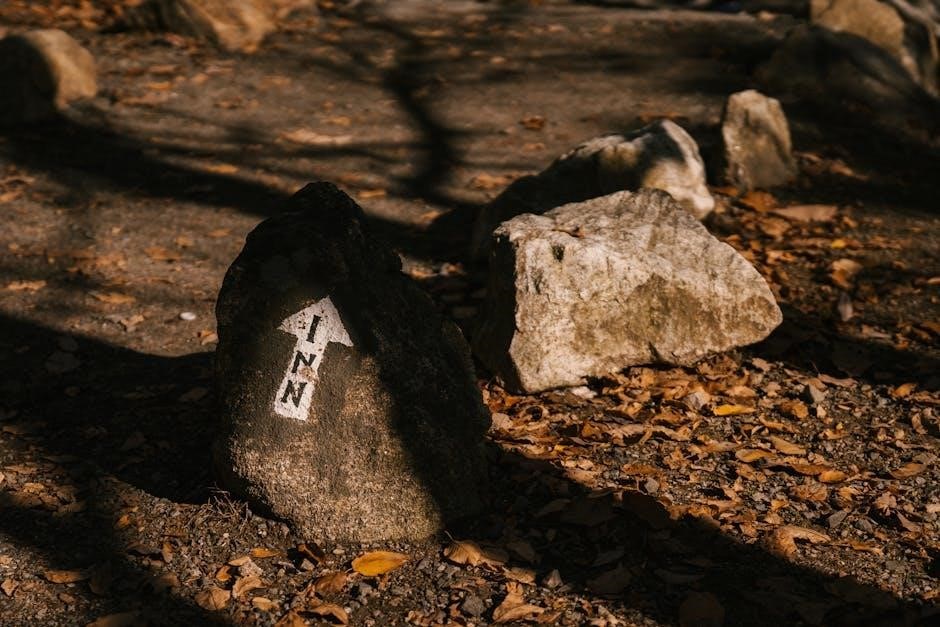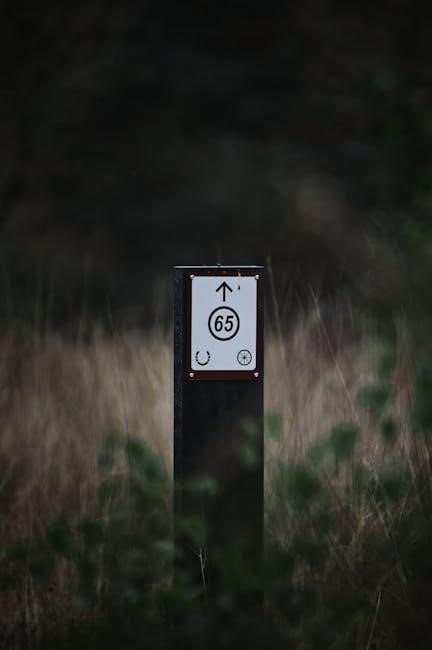Tristan Gooley’s The Walker’s Guide to Outdoor Clues and Signs offers a comprehensive exploration of natural navigation, revealing how to interpret the land, sun, moon, stars, plants, and animals to uncover hidden patterns and predict changes in the environment. This guide equips walkers with essential skills to decode nature’s signals, fostering a deeper connection with the outdoors and enhancing survival instincts. By mastering these clues, anyone can navigate confidently, even in unfamiliar territories, using the world as their compass.
Understanding the Importance of Natural Navigation
Natural navigation is an essential skill that connects us to the environment, fostering situational awareness and self-reliance. By interpreting clues from nature, such as the sun’s position, tree growth patterns, and animal behavior, individuals can navigate confidently without modern tools. This timeless practice not only enhances survival instincts but also deepens our appreciation for the natural world. Tristan Gooley’s guide emphasizes how these skills empower walkers to predict environmental changes, locate water, and stay oriented, making it a vital tool for outdoor enthusiasts.
Key Skills for Interpreting Outdoor Signs
Mastering natural navigation requires keen observation, situational awareness, and the ability to interpret subtle clues. Skills include identifying patterns in tree growth, tracking animal behavior, and reading cloud formations. These abilities allow individuals to predict weather changes, locate water sources, and navigate without modern tools. By refining these skills, walkers can enhance their connection with nature and gain confidence in the wild, as highlighted in Tristan Gooley’s guide, which offers practical insights for deciphering the outdoors effectively.

Animal Tracking and Behavior
Understanding animal tracks and behavior reveals vital outdoor clues, helping walkers predict weather, locate water, and navigate. Observing mammal signs and bird reactions enhances survival skills and connection with nature.
Recognizing Tracks and Signs of Mammals
Tristan Gooley’s guide highlights the importance of identifying mammal tracks and signs, such as footprints, scat, and feeding patterns, to understand their behavior and habitat preferences. These clues not only aid in navigation but also reveal the biodiversity of an area. By analyzing track size, shape, and grouping, walkers can deduce the species, its movement, and potential threats or water sources nearby. This skill enhances survival instincts and deepens the connection with nature, making every walk an opportunity for discovery and learning.
Interpreting Bird Behavior for Environmental Clues
Bird behavior serves as a powerful environmental indicator, offering insights into weather changes, predator presence, and water sources. Tristan Gooley’s guide emphasizes observing flight patterns, flock movements, and vocalizations to decode these signals; For instance, birds flying low may signal approaching rain, while sudden silence could indicate a predator nearby. By paying attention to these cues, walkers can better understand their surroundings, predict environmental shifts, and navigate more effectively, turning bird behavior into a valuable navigation tool in the wild.

Natural Navigation Techniques
Natural navigation techniques involve using the sun, moon, stars, and terrain features to determine direction and predict environmental changes, enhancing outdoor awareness and survival skills effectively always.
Using the Sun, Moon, and Stars for Direction
Tristan Gooley’s guide highlights how celestial bodies provide reliable navigation cues. The sun’s position varies by time and season, while the moon’s phases indicate direction. Stars like the North Star remain constant, offering precise orientation. By observing these natural markers, walkers can determine direction without modern tools, relying on ancient, timeless methods that connect humanity to the cosmos. This skill enhances outdoor adventures, fostering self-reliance and a deeper appreciation for nature’s inherent guidance systems, as detailed in The Walker’s Guide.
Reading Terrain Features for Orientation

Understanding terrain features is crucial for navigation, as highlighted in The Walker’s Guide to Outdoor Clues and Signs. Contour lines, valleys, and ridges reveal direction and elevation changes. Water flows downhill, indicating lower ground, while natural landmarks like peaks or unique rock formations serve as waypoints. By observing these geological patterns, walkers can orient themselves without modern tools, relying on the Earth’s natural topography to guide their path and ensure they stay on course in unfamiliar landscapes.
Weather Forecasting in the Wild
The Walker’s Guide to Outdoor Clues and Signs teaches how to predict weather changes by observing cloud formations, wind patterns, and animal behavior, ensuring preparedness in nature.
Identifying Cloud Formations and Wind Patterns
Tristan Gooley’s guide highlights how cloud formations and wind patterns reveal upcoming weather changes. By recognizing shapes like cumulus, stratus, and cirrus clouds, walkers can anticipate storms or fair skies. Wind direction shifts often signal approaching low-pressure systems, while steady winds may indicate stable conditions. Observing these natural indicators allows for accurate weather predictions, enhancing safety and planning during outdoor adventures. This skill, once mastered, becomes an invaluable tool for navigating the wild with confidence and preparedness.
Predicting Weather Changes Through Observation
Tristan Gooley’s guide emphasizes the importance of observing natural signs to predict weather changes. By studying cloud formations, wind patterns, and animal behavior, walkers can anticipate shifts in conditions. For instance, towering cumulonimbus clouds often signal approaching storms, while sudden changes in wind direction may indicate low-pressure systems. Additionally, animals frequently alter their behavior before weather changes, offering subtle clues. These observational skills enable walkers to stay prepared and safe, leveraging nature’s signals to forecast the weather accurately.

Plant Life and Outdoor Clues
Plant life offers vital clues for outdoor navigation and survival. Tristan Gooley’s guide reveals how to identify edible plants and interpret growth patterns that indicate water sources, providing essential navigation insights.
Identifying Edible Plants and Their Uses
Tristan Gooley’s guide highlights the importance of recognizing edible plants, such as wild berries, herbs, and roots, which can be crucial for survival. By understanding plant characteristics, textures, and growth patterns, walkers can safely forage for food. Additionally, certain plants serve multiple purposes, offering both sustenance and medicinal value. Learning to identify these species not only enhances outdoor navigation skills but also deepens one’s connection with nature, fostering self-reliance and environmental awareness in the wild.
Reading Plant Growth Patterns for Water Sources
Plants often reveal the presence of water through their growth patterns. Lush vegetation, such as willows or alders, typically thrives near water sources. Areas with dense grasses or reeds may indicate underground streams. Observing the direction in which trees lean or the thickness of their roots can also signal water proximity. By studying these plant signs, walkers can locate water effectively, enhancing navigation and survival skills in the wilderness. This method, as outlined in Tristan Gooley’s guide, emphasizes the importance of nature’s subtle cues.

The Role of Water in Navigation
Water plays a crucial role in navigation by revealing flow patterns and natural signs. Observing streams and vegetation helps walkers locate sources and understand terrain dynamics effectively.
Locating Water Sources Through Observation
Tristan Gooley’s guide highlights how to pinpoint water sources by observing natural clues. The shape of valleys often reveals where water flows, while certain rocks act as natural dams. Trees with roots growing toward a specific direction may indicate underground water. Moss on tree trunks and color changes in soil also signal water presence. By studying these signs, walkers can reliably locate water, even in arid landscapes, ensuring survival and navigation success.
Understanding Water Flow and Its Implications
Water flow reveals invaluable insights into a landscape’s history and structure. Rivers and streams often indicate the direction of larger water sources, while tributaries suggest the main river’s location. Erosion patterns expose the land’s underlying geology, and the shape of river meanders can predict subsurface features. By studying how water moves, walkers can infer distant water sources, land contours, and potential hazards. This knowledge enhances navigation and survival skills, making water flow a critical clue in outdoor environments.
Tristan Gooley’s Contributions to Outdoor Navigation

Tristan Gooley’s work revolutionized natural navigation by compiling over 850 outdoor clues, enabling walkers to predict weather, track animals, and locate water. His methods bridge ancient skills with modern practicality, empowering adventurers to connect deeply with nature and enhance survival instincts. His comprehensive guides have become indispensable tools for outdoor enthusiasts, offering accessible wisdom for navigating the wild effectively.
The Walkers Guide to Outdoor Clues and Signs
Tristan Gooley’s The Walker’s Guide to Outdoor Clues and Signs is a groundbreaking resource that unlocks the secrets of natural navigation. Packed with over 850 clues, this guide reveals how to interpret the land, sky, plants, and animals to predict weather, locate water, and track wildlife. Whether for city strolls or wilderness treks, it empowers walkers to decode nature’s signals, fostering a deeper connection with the environment. The book is a must-have for outdoor enthusiasts seeking to enhance their survival skills and navigation abilities in any setting.
Practical Applications of His Methods
Tristan Gooley’s methods offer practical tools for enhancing outdoor navigation and survival skills. By learning to interpret natural signs, walkers can predict weather changes, locate water sources, and track wildlife. These techniques empower individuals to connect deeply with nature, fostering confidence in various environments. Gooley’s insights are invaluable for both seasoned explorers and beginners, providing a comprehensive approach to understanding the outdoors and navigating effortlessly using the world’s natural cues.
